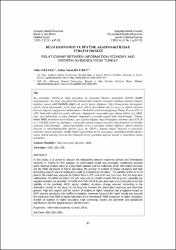Bilgi Ekonomisi ve Büyüme Arasındaki İlişki: Türkiye Örneği
Abstract
Bu çalışmada, Türkiye’de bilgi ekonomisi ile ekonomik büyüme arasındaki ilişkinin analizi amaçlanmıştır. Bu amaç için geliştirilen ekonometrik modelde ekonomik büyümeyi temsilen bağımlı değişken olarak sabit fiyatlarla gayri safi yurtiçi hasıla değişkeni, bilgi ekonomisinin göstergeleri olarak yüksek öğretimdeki Ar-Ge insan gücü, yüksek öğretimdeki öğrenci sayısı ve yüksek teknoloji ihracatı bağımsız değişkenleri kullanılmıştır. Modeldeki serilerin durağanlığı Philips Perron (PP) ve ADF birim kök testleri ile analiz edilmiştir. Değişkenler arasındaki uzun dönem ilişkisi için ARDL sınır testi kullanılmış ve uzun dönemde değişkenler arasında negatif ilişki belirlenmiştir. Tahmin edilen ARDL modelinin kararlılığının, yani yapısal değişme olup olmadığının sınaması için CUSUM ve CUSUMQ testleri de yapılmıştır. Çalışmanın tahmin sonuçlarına göre bilgi ekonomisi ile büyüme arasında uzun dönemde; yüksek öğretimdeki Ar-Ge insan gücü anlamlı değilken, yüksek teknoloji ihracatı ve yükseköğretimdeki öğrenci sayısı da GSYH’yı negatif yönden etkilemiş ve katsayılar istatistiki olarak anlamlıdır. Ancak, Yüksek öğretimdeki Ar-Ge insan gücü, yükseköğretimdeki öğrenci sayısı, yüksek teknoloji ihracatı kısa dönemde birinci gecikmeli değerde pozitif ve istatistiksel olarak anlamlıdır. In this study, it is aimed to analyze the relationship between economic growth and information economy in Turkey.For this purpose, an econometric model was developed considering constant gross national product value as a dependent variable and the indicators of the information economy are the R&D manpower in higher education, the number of students in higher education and high technology exports were included into model as independent variables.. The stability of the series of data in the model was analyzed by Philips Perron (PP) and ADF unit root tests. For the long term relationship, the ARDL boundary test was used and test results showed that long term variables are negative between the variables. CUSUM and CUSUM-of-Square tests were also conducted to test the stability of the predicted ARDL model, whether structural change occured. According to the estimation results of the study, in the long run between the information economy and economic growth; High-tech exports and the number of students in higher education had a negative impact on GDP and are consistent with coefficient statistics. However, based on the model results was reached the conslusion that R&D in higher education is not meaningful. R&D manpower in higher education, number of students in higher education, high technology exports are positively and statistically significant in the first lagged value in the short term.
Volume
23Issue
1Collections
The following license files are associated with this item:


















